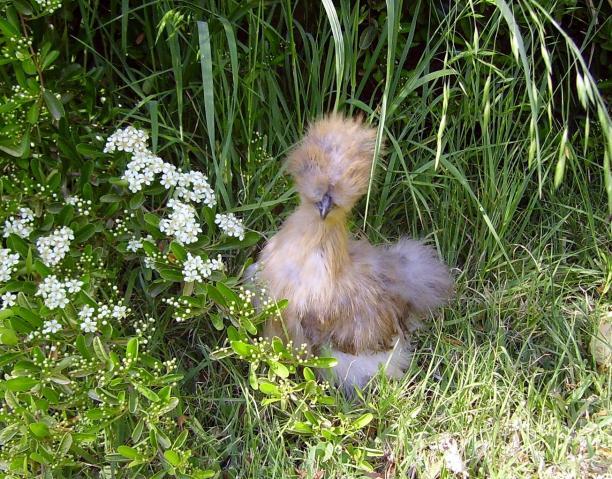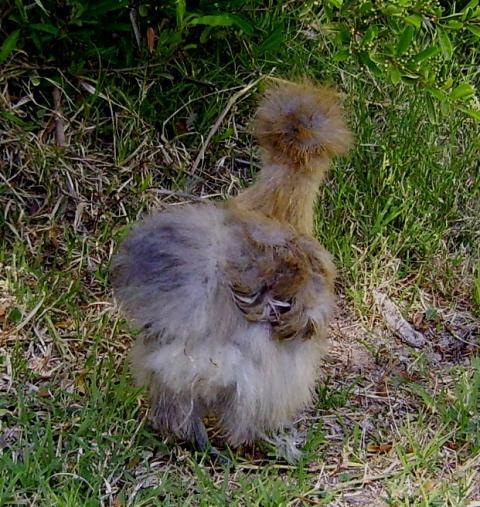Oh yes, it happens. My RV buff from Nationals had a few flecks of black in her tail, she molted in the fall and for nationals was pretty much clear. She's molted again recently and I've noticed a few black specks have come back. Granted I've not ever seen it come back RAMPID and take over the tail/wings, but there will be times when you see more/less black.
Navigation
Install the app
How to install the app on iOS
Follow along with the video below to see how to install our site as a web app on your home screen.
Note: This feature may not be available in some browsers.
More options
You are using an out of date browser. It may not display this or other websites correctly.
You should upgrade or use an alternative browser.
You should upgrade or use an alternative browser.
Silkie color genetics
- Thread starter eestep8
- Start date
- May 13, 2009
- 6
- 0
- 6
I have puttered around looking for information on color genetics and not been able to find what I need, but this thread looks very promising

What happens when breeding white to splash/blue/black? If white is flat out dominant, there's not much sense setting up my birds to try it out. What I am hoping is that crossing a white hen with a splash roo will yield some portion of splash chicks. My 85 y.o. mom (since we left her a hen to take care of for a weekend) has absolutely fallen in love with splash silkies! Have tried getting hatching eggs through the mail, but somewhere along the line to us there must be a scrambling center

Anyhow, advice and information will be much appreciated

What happens when breeding white to splash/blue/black? If white is flat out dominant, there's not much sense setting up my birds to try it out. What I am hoping is that crossing a white hen with a splash roo will yield some portion of splash chicks. My 85 y.o. mom (since we left her a hen to take care of for a weekend) has absolutely fallen in love with splash silkies! Have tried getting hatching eggs through the mail, but somewhere along the line to us there must be a scrambling center

Anyhow, advice and information will be much appreciated
Last edited:
Silkies are almost always recessive white. Which means to be white, they must carry two copies of the recessive white allele. Recessive white is very good at covering all other colour and pattern genes present in the bird, so when you breed white to white, you have no idea what colour genes are being mixed together. Generations later of white to white breeding you have absolutely no idea of what other colours or patterns are present in an individual bird. With the exception of each carrying two copies of recessive white, they are all genetically uniquely individual.
Whe you cross a recessive white bird to a specific colour (such as splash/blue/black) and ask for the result, you might as well say "if I breed my splash/blue/black bird to an unknown bird, what colour of chicks will they have?
Going with your known colours: black will never parent a splash bird; blue will about half the time if bred to a splash, and about a quarter of the time is bred to a blue. Splash bred to splash will give 100% splash.
Yes, it is possible to get a splash out of a white bird if bred to a blue or splash--but the odds are stacked against it. The likelihood of various patterns showing up and the unlikelihood of the bird carrying blue or splash speaks against it.
Whe you cross a recessive white bird to a specific colour (such as splash/blue/black) and ask for the result, you might as well say "if I breed my splash/blue/black bird to an unknown bird, what colour of chicks will they have?
Going with your known colours: black will never parent a splash bird; blue will about half the time if bred to a splash, and about a quarter of the time is bred to a blue. Splash bred to splash will give 100% splash.
Yes, it is possible to get a splash out of a white bird if bred to a blue or splash--but the odds are stacked against it. The likelihood of various patterns showing up and the unlikelihood of the bird carrying blue or splash speaks against it.
Quote:
With the way Silkies are feathered, the Lacing isn't gunna show up well. It might as well be all scattered black and white. Good luck trying though, it would be interesting..
With the way Silkies are feathered, the Lacing isn't gunna show up well. It might as well be all scattered black and white. Good luck trying though, it would be interesting..
- May 13, 2009
- 6
- 0
- 6
Sonoran, thank you, exactly what I needed to know! I may as well try it, venishly small chance is better than none at all
 , and will put my two blue silkie cosses in there as well. The silkie x d'uccle is the best lil mama hen on the planet
, and will put my two blue silkie cosses in there as well. The silkie x d'uccle is the best lil mama hen on the planet



I know that it is unknown what will come out of a white breeding to a black but what colors are possible? Is it ever possible to get a true color out of it?
Last edited:
Well, first you need to define "true colour."

Yes, you could get a colour that meets the standard for a specific variety.
For example, if you are breeding a specific variety (doesn;t matter which) and you have a cock and a hen who each carry one copy of recessive white, you will hatch some white chicks. In this case you know their genetic background, and if you take one of those white birds and breed it back into your coloured birds it will breed as true as any other random bird selected from your flock.
However in most cases you don't have a clue as to the genetic makeup of your whites, so you don't really know how to pair each one. What you can do if some test breeding to see what colours segregate out of a specific bird. Black is probably the colour least likely to add in various pattern or colour modifiers.

Yes, you could get a colour that meets the standard for a specific variety.
For example, if you are breeding a specific variety (doesn;t matter which) and you have a cock and a hen who each carry one copy of recessive white, you will hatch some white chicks. In this case you know their genetic background, and if you take one of those white birds and breed it back into your coloured birds it will breed as true as any other random bird selected from your flock.
However in most cases you don't have a clue as to the genetic makeup of your whites, so you don't really know how to pair each one. What you can do if some test breeding to see what colours segregate out of a specific bird. Black is probably the colour least likely to add in various pattern or colour modifiers.
Hi all -
Interesting topic!
Can any of you tell me about the partridge gene and how it is passed on? How about birchen?
I'm pretty well versed in other avian genetics (cockatiel, lovebird, Indian ringneck, etc...), but I'm getting conflicting info on how partridge and birchen applies to chickens.
Also, can anyone show me exactly what a "blue partridge" silkie looks like?
Thanks so much -
Kathy
Interesting topic!
Can any of you tell me about the partridge gene and how it is passed on? How about birchen?
I'm pretty well versed in other avian genetics (cockatiel, lovebird, Indian ringneck, etc...), but I'm getting conflicting info on how partridge and birchen applies to chickens.
Also, can anyone show me exactly what a "blue partridge" silkie looks like?
Thanks so much -
Kathy
Easy part--here is a young blue partridge pullet that I am very happy with. She's enough older that I took her to a show last weekend



Okay, now for the hard part. Almost all silkies have the e^b allele. That makes partridge an easy colour to generate. Makes solid colours hard and makes birchen near impossible (as best I can tell--start a project using birchen cochins or polish (are they available?) bred to black silkies with silver hackles).
Partridge is not a gene, b ut a combination of genes. The best partridges should carry mahogany, but it isn't required to have the partridge pattern. You need Pg (preferably in two doses) on an e^b base, and for partridge you need gold (ss or s-).
For males, an e+, E^R or E^Wh base will have a similar appearance.
For females the e+ will also have a correct phenotype, but E^R or E^Wh will be incorrect.
Silkie feathering makes assessment of the penciling quality difficult, and the addition of Ml, Co and/or Db can be accommodated on females with silkie feathering; the difference is more noticeable on males. Without silkie feathering any of these gene variations would be noticeable on both genders.



Okay, now for the hard part. Almost all silkies have the e^b allele. That makes partridge an easy colour to generate. Makes solid colours hard and makes birchen near impossible (as best I can tell--start a project using birchen cochins or polish (are they available?) bred to black silkies with silver hackles).
Partridge is not a gene, b ut a combination of genes. The best partridges should carry mahogany, but it isn't required to have the partridge pattern. You need Pg (preferably in two doses) on an e^b base, and for partridge you need gold (ss or s-).
For males, an e+, E^R or E^Wh base will have a similar appearance.
For females the e+ will also have a correct phenotype, but E^R or E^Wh will be incorrect.
Silkie feathering makes assessment of the penciling quality difficult, and the addition of Ml, Co and/or Db can be accommodated on females with silkie feathering; the difference is more noticeable on males. Without silkie feathering any of these gene variations would be noticeable on both genders.
VERY nice baby! What is a silver gene on a silkie?
New posts New threads Active threads
-
Latest posts
-
-
-
-
Shadrach's Ex Battery and Rescued chickens thread.
- Latest: Mother of Chaos
-
-
Latest threads
-
Do we think this chicken can heal?
- Started by Mklein176
- Replies: 1
-
B complex dosage
- Started by my beautiful girls
- Replies: 0
-
-
-
-
-
Threads with more replies in the last 15 days
-
-
-
I culled my first cockerel, now what?
- Started by redinator
- Replies: 108
-
*Answer These Questions The Best You Can Please *
- Started by N3mesis_IceWing_NightWing
- Replies: 69
-
-
×

